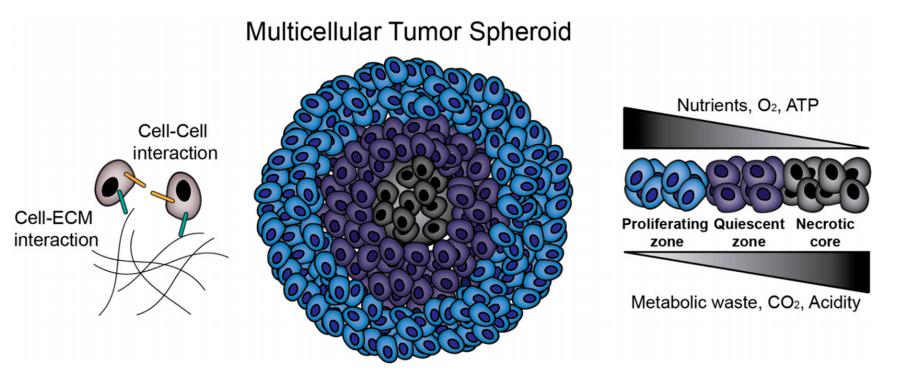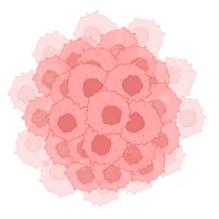3D Spheroid Platform for Drug Development
3D spheroids are formed by culturing cells in a three-dimensional environment, enabling them to interact and form complex structures like those found in vivo. In 3D multicellular spheroids, metabolic gradients can form, resulting in a diverse mix of cells that interact exceptionally well with each other and the extracellular matrix. Compared to traditional 2D cell culture, 3D spheroids provide a more realistic representation of the body's environment and effectively mimic various tissue types in diseased conditions, enhancing clarity and fluidity.
 Figure 1. Multicellular tumor spheroids (MCTS) biology.[1]
Figure 1. Multicellular tumor spheroids (MCTS) biology.[1]
3D spheroids have emerged as a powerful tool in drug development, offering significant advantages over traditional 2D cell culture systems. These spherical aggregates of cells better mimic the in vivo tumor microenvironment, providing insights into cellular behavior, drug responses, and the overall efficacy and safety of therapeutic compounds.
Features
- Structural Relevance
3D spheroids maintain a more physiologically relevant architecture compared to 2D cultures. They can better replicate cell-cell and cell-matrix interactions, which are crucial for cellular functions.
- Microenvironment Simulation
The internal gradients of nutrients, oxygen, and pH in 3D spheroids mimic those found in solid tumors, making them particularly useful for studying tumor biology and drug response.
- Cell-typical Behavior
Cells in 3D cultures often exhibit differentiated phenotypes and behaviors, such as altered gene expression and increased resistance to drugs, closely resembling the in vivo situation.
3D Spheroid Models Applications
- Cancer Research
3D spheroids are used to model tumor growth and metastasis. They provide a more accurate representation of tumor microenvironments compared to traditional 2D cultures, allowing researchers to study drug responses, cellular behavior, and treatment efficacy.
- Drug Development and Screening
Spheroids provide a more predictive platform for testing the efficacy and toxicity of new pharmaceuticals. They mimic the in vivo environment better than 2D cultures, helping to identify potential drug candidates early in the development process.
- Toxicology Testing
Spheroids can be used to evaluate the toxicological effects of chemicals and drugs, providing insights into safety and efficacy before clinical trials.
- Migration and Invasion Assays
Cancer cells in 3D spheroids display behaviors more similar to those observed in tumors, including heterogeneity and phenotypic variations, which are crucial for studying the biology of cancer cell migration and invasion.
Creative Bioarray provides advanced 3D spheroid models designed for researchers aiming to explore cell behavior in a more realistic environment. Our 3D Spheroid for Drug Development enables in-depth investigation of cell-cell interactions, drug responses, and cell migration, offering enhanced physiological relevance for your studies.


Reference
- Kim, Sungjin et al. "Uniform sized cancer spheroids production using hydrogel-based droplet microfluidics: a review." Biomedical microdevices vol. 26,2 26. 29 May. 2024, doi:10.1007/s10544-024-00712-3
Explore Other Options